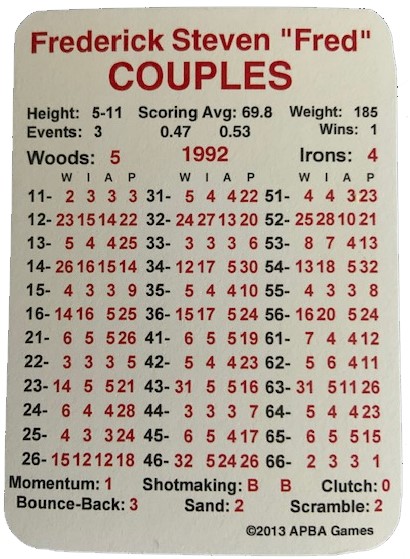This post is an initial look at the 1992 Frederick Steven “Fred” Couples card, focusing mainly on his carry distance and accuracy off the tee using a driver. We’ll dissect it, so that you can get a leg up on your competition…
Most tee shots with a driver roll 25 – 30 yards if they land in the fairway, half that if they land in the regular rough. Since where a shot lands is highly dependent on the characteristics of the hole, we’ll just consider the distance his shots carry and their deviation from the centerline. We’ll also assume there is no wind.
Typical Carry Distance of 255 – 265 Yards
His average carry distance for all 36 possible outcomes using a driver is 262.36 yards. He has two chances of hitting a drive that carries 305 yards and three chances of getting his shortest possible carry of 245 yards. His most common carry distances are 255 yards and 260 yards which are both listed 8 times on his card. If you add in the carry distance of 265 yards, which appears 5 times on his card, you can expect the ball to carry 255 – 265 yards 58.33% of the time.

Slight Tendency to Go Right
As you can see from the accompanying image, Freddie has an Average W value of 5. His card has six 5’s in the W column, so 16.6% of the time he will hit his Average W and be able to adjust his accuracy 5 yards towards the centerline. Using a driver, this drive would carry 260 yards left 15 (or left 10 if you choose to use his Average W “bonus”).
Tee shots tend to go right with numbers that are even in the W column and left, if the number is odd. There are exceptions to this for a driver (34, 35, and 36), but Fred doesn’t have any of those numbers on his card in the W column. He has a total of 19 even results and only 17 odd results, which means 52.8% of the time he will go right, and 47.2% of the time he will go left.
Tee Shots to the Left are Slightly Longer and More Accurate
When Fred hits the ball left with a driver he averages 264.70 yards, which is slightly longer than his overall average (by 2.34 yards). His average deviation to the left is 19.4 yards. If you take the 6 times he rolls his Average W of 5 and apply those adjustments, he then averages 14.3 yards to the left.
His largest deviation to the left is 45 yards, which appears just once on his card. The least deviation he has to the left using a driver is 10 yards, which occurs 3 times. If you add the 6 times you use his Average W, he hits the ball 10 yards to the left with a driver 52.94% of the time.
When he hits the ball right with a driver it averages 260.26 yards, almost 5 yards shorter than his average to the left. The ball also goes on average 21.05 yards to the right, which is slightly more than when he hits to the left (1.65 yards). The widest shot right is 45 yards, and it only occurs once on his card. The least amount of deviation to the right is 10 yards, and it, too, is only listed once. In other words, when he drives the ball right, it only has about a 5% chance of going as much as 45 yards off the centerline or 10 yards off the centerline.
His most common deviation hitting right is 15 yards, which is listed 11 times out of the 19 possible outcomes (57.89%). If Freddie hits it right, more than half the time it will be by 15 yards, so plan accordingly. A wide open fairway with plenty of space on the right can help Freddie score well on that hole.
Game Strategy
Freddie tends to hit the ball to the right more than the left (although it is close), and when he does hit it right, you’re going to be farther away from the centerline by a fair amount. You shouldn’t hope for a lucky shot going right, because only 5% of the time will it end up being just 10 yards to the right. More than likely you are going to be 20+ yards from center.
He will look to carry the ball somewhere in the 255 – 265 range most of the time, so you should plan accordingly with the normal 25 – 30 yards of roll. If there is trouble on the right side of the fairway anywhere in this range, it is best to aim left by 10 yards or more. Trouble on the left side of the fairway isn’t as worrisome, since he tends to keep a better ball location on that side and has much better control of mishits to this side.
It’s not very often (just 5.55% of the time) but Freddie can get ahold of one from the tee box and drive it 350 yards including the roll. With this low chance of happening, you shouldn’t worry about him blasting it too far. But those times he rolls a 43 or 63 on his card could cause you some trouble. Fortunately, it only goes 10 yards left when that happens, so if you have plenty of open space on that side of the fairway this could be a boon for you.
In future posts, I’ll look at other characteristics of Couples’ card.
Nicely done.
thanks..